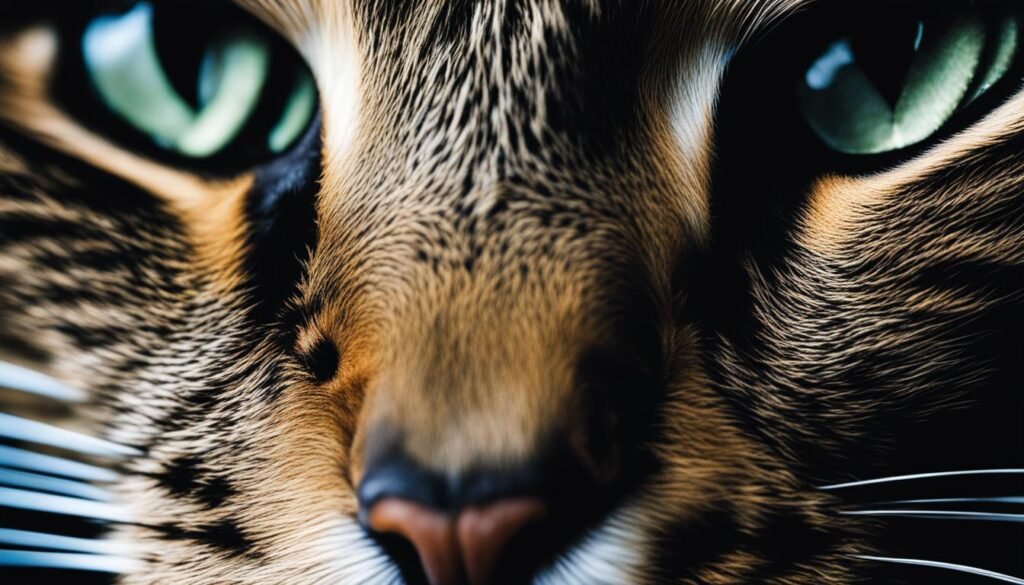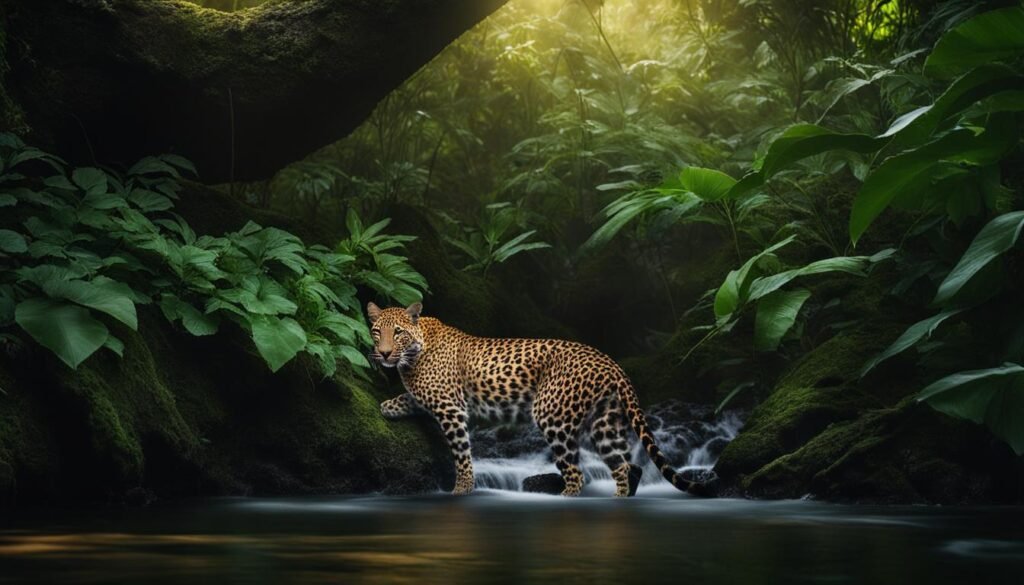Cats are fascinating creatures with a wide range of behaviors and skills. One of their most intriguing abilities is their talent for hunting at night. When darkness falls, cats tap into their nighttime hunting instincts, showcasing a remarkable set of skills that allow them to navigate the shadows and capture their prey. In this article, we will delve into the secrets behind cats’ night hunting prowess and shed light on the mysteries that shroud their nocturnal activities.
Key Takeaways:
- Night hunting is a unique ability that cats possess, tapping into their nighttime hunting instincts.
- Cats utilize a combination of sensory cues, such as whiskers, in order to navigate and detect changes in their environment during nighttime hunts.
- Through millions of years of evolution, cats have developed specialized adaptations that enable them to thrive in various landscapes and habitats.
- Cats employ different hunting techniques, such as ambush strategies and camouflage, to increase their chances of success during nighttime hunts.
- Certain cat species have enhanced night vision, allowing them to excel as nocturnal hunters and employ specific hunting strategies to ensure their survival.
The Role of Whiskers in Night Hunting
Whiskers, also known as vibrissae, are not just cute features on a cat’s face; they serve a vital purpose in their nighttime hunting adventures. These specialized sensory organs are far more than just long hairs. They are packed with nerve endings that provide cats with valuable information about their environment.
Designed to be incredibly sensitive, whiskers help cats navigate and detect changes in their surroundings. They act as a sort of radar system, allowing cats to determine whether they can fit through narrow spaces or leap onto high surfaces. When a cat’s whiskers come into contact with an object, the sensory information is sent to its brain, providing clues about the object’s distance, texture, and movement.
Additionally, a cat’s whiskers play a crucial role in their hunting skills. They aid in spatial awareness, allowing cats to make precise calculations and adjustments as they stalk their prey. By observing a cat’s whiskers, we can gain insights into their mood and intentions. When a cat is feeling relaxed, its whiskers will be positioned forward. However, if the cat feels threatened or agitated, its whiskers will be pulled back against its face.
Whiskers are an ingenious tool that give cats a heightened sense of their environment, helping them navigate and hunt with precision in the dark.
To fully appreciate the importance of whiskers, imagine trying to maneuver and hunt in complete darkness. The sensory information provided by these remarkable sensory organs gives cats a significant advantage in their nighttime hunting pursuits. And next time you see a cat, take a moment to admire their whiskers – they are not only adorable but also a testament to the amazing abilities of these fascinating creatures.
| Whisker Function | Importance |
|---|---|
| Spatial awareness | Allows cats to navigate and make precise calculations while hunting. |
| Obstacle detection | Helps cats determine whether they can fit through narrow spaces or leap onto high surfaces. |
| Sensory information | Provides valuable clues about an object’s distance, texture, and movement. |
| Mood and intention indication | Offers insights into a cat’s emotional state and intentions. |

The Evolutionary Journey of Night Hunting Cats
Cats have a long and fascinating evolutionary journey that has shaped their ability to hunt at night. It all began with their primitive tree-climbing ancestors in the rainforests over 11 million years ago. These early cats faced various challenges and had to adapt to different environments, leading to the development of unique features and hunting techniques.
One of the earliest cats to play a significant role in the evolution of night hunting is the clouded leopard. It shares genetic similarities with all modern cats, making it a crucial reference point for understanding their evolutionary history. The clouded leopard’s adaptations include large canines and powerful jaws that allow it to take down prey quickly and efficiently.
Another remarkable example of adaptation is seen in the fishing cat. This feline has evolved specialized features to thrive in wetland environments. Its webbed paws enable efficient swimming, while its markings provide excellent camouflage among aquatic vegetation. The fishing cat’s ability to adapt to a semi-aquatic lifestyle demonstrates the incredible versatility of cats as a group.
The Evolution of Adaptations in Night Hunting Cats
Over time, cats have developed various adaptations that enhance their nighttime hunting abilities. These adaptations include exceptional night vision, acute hearing, and a heightened sense of smell. Additionally, cats have evolved flexible bodies and sharp retractable claws that allow them to climb trees and pounce on unsuspecting prey from above.
| Cat Species | Adaptations |
|---|---|
| Clouded Leopard | Large canines, powerful jaws |
| Fishing Cat | Webbed paws, camouflage markings |
| Leopard | Exceptional night vision, camouflage markings |
| Tiger | Exceptional night vision, powerful build |
| Domestic Cat | Night vision, retractable claws |
The table above highlights some of the key adaptations seen in different species of night hunting cats. These features enable them to effectively stalk, ambush, and capture their prey in low-light conditions.
A cat’s ability to adapt and thrive in various environments is a testament to its remarkable evolutionary journey. From rainforests to wetlands, cats have conquered different habitats by developing unique physical traits and hunting strategies. Their ability to hunt at night is a reflection of their evolutionary success.
By unraveling the evolutionary history of night hunting cats, we can gain a deeper appreciation for their incredible adaptations and hunting prowess. From their primitive tree-climbing ancestors to the diverse species we see today, cats continue to inspire awe and intrigue with their ability to navigate the darkness and emerge as skilled nocturnal hunters.
Hunting Techniques of Night Hunting Cats
Cats, including domestic cats, are instinctual ambush predators. From a young age, they engage in play to develop their hunting skills. Dopamine released in their brains drives their playful behavior. Cats also possess natural camouflage, adapting their markings and colors to blend into their surroundings. Different hunting techniques, such as slow stalking in grass or hunting at dawn and dusk, have evolved based on their habitat.
One of the primary hunting techniques of night hunting cats is stalking. They stalk their prey silently, moving slowly and carefully to avoid detection. Their agile bodies and sharp senses allow them to approach their prey with precision. Once they are within striking distance, they pounce, using their powerful hind legs to launch themselves towards their prey and deliver a quick and lethal bite.
Another technique employed by night hunting cats is the element of surprise. They use their natural camouflage to blend into the environment, making it difficult for their prey to detect them. This allows them to get close to their prey unnoticed, increasing their chances of a successful hunt. Cats also take advantage of their surroundings, such as using tall grass or trees to hide and wait for the perfect moment to strike.
“Cats are masters of surprise attack. Their ability to blend into their surroundings and stalk their prey with stealth is truly remarkable.” – Wildlife expert
Predator Training
Predator training plays a crucial role in the development of a cat’s hunting skills. Even domestic cats exhibit this behavior through play. Kittens engage in mock hunting exercises, chasing after toys or their littermates, honing their reflexes and agility. Through play, they learn to stalk, pounce, and capture their prey effectively.
Training continues into adulthood as cats refine their hunting techniques. They learn to adapt to different environments and prey, utilizing their skills to maximize their hunting success. This predator training is essential for their survival, ensuring they are capable of catching their prey in the harsh conditions of the night.
Camouflage
Cats possess a remarkable ability to blend into their surroundings through their camouflage. Their coat patterns and colors help them blend into the environment, making it difficult for their prey to spot them. For example, the coat of a leopard has rosette patterns that resemble the dappled sunlight filtering through the trees, allowing them to disappear into the foliage.
In addition to their coat, cats also utilize their body posture and movements to further enhance their camouflage. They crouch low to the ground, minimizing their silhouette, and move with stealth to avoid detection. This combination of camouflage techniques allows night hunting cats to remain hidden from their prey until the very last moment, increasing their chances of a successful hunt.
| Hunting Techniques | Description |
|---|---|
| Stalking | Moving slowly and silently towards prey before launching a surprise attack |
| Ambushing | Hiding and waiting for the perfect moment to strike, using natural camouflage |
| Predator Training | Engaging in play as kittens to develop hunting skills |

Night Vision and Hunting Strategies
When it comes to hunting, nocturnal hunters like leopards and tigers have developed remarkable strategies that give them an edge in the darkness. These predators possess enhanced night vision, allowing them to navigate and hunt effectively in low light conditions. Their eyes are specialized to capture as much available light as possible, enabling them to spot prey that would be invisible to human eyes.
Leopards, known for their stealthy nature, have a unique hunting strategy. After successfully making a kill, they often drag their prey up trees to keep it safe from scavengers. By hoisting their meal into the branches, leopards protect their hard-earned catch and ensure they have a reliable source of food. Tigers, on the other hand, bury their kills in secluded locations, carefully concealing them from potential thieves. This method allows tigers to feed their young and minimize the risk of other predators stealing their hard-earned meal.
Understanding these hunting strategies provides valuable insights into the behavior and survival mechanisms of these fascinating creatures. Nocturnal hunters have evolved to not only excel in the darkness but also to adapt their hunting techniques for optimal efficiency and success.
Night Vision Comparison: Leopard vs. Tiger
| Leopard | Tiger | |
|---|---|---|
| Enhanced Night Vision | Yes | Yes |
| Preferred Hunting Strategy | Dragging prey up trees | Burying kills |
| Reason for Strategy | Protect prey from scavengers | Feed young and minimize theft |
Quotes:
“These nocturnal hunters have evolved to master the art of hunting in the darkness, utilizing their enhanced night vision to their advantage.” – Wildlife researcher
- Nocturnal hunters possess enhanced night vision.
- Leopards drag their prey up trees, protecting it from scavengers.
- Tigers bury their kills to feed their young and reduce the risk of theft.
By studying the hunting strategies and adaptations of these nocturnal hunters, researchers gain valuable insights into the natural world. The secrets of their enhanced night vision and hunting techniques continue to fascinate and inspire scientists and wildlife enthusiasts alike.
Adaptations for Night Hunting
When it comes to night hunting, cats have developed fascinating adaptations that allow them to thrive in diverse environments. One such adaptation is the presence of webbed paws, which enables certain cats like the fishing cat to engage in semi-aquatic hunting.
The fishing cat is equipped with webbed toes, allowing it to swim effortlessly and catch aquatic prey. This unique feature sets it apart from other cats and highlights its specialized hunting abilities in wetlands.
Additionally, many cats possess remarkable climbing abilities, which aid them in both hunting and escaping potential threats. Species such as the clouded leopard and domestic cats have evolved to navigate trees with ease, using their sharp claws and muscular bodies to climb and seek out prey in elevated areas.
“The webbed paws of the fishing cat and the climbing abilities of various cat species are just a few examples of the incredible adaptations that allow these feline hunters to excel in their nocturnal pursuits.” – Expert Quote
These adaptations not only showcase the versatility of cats but also emphasize their ability to adapt to different habitats and hunting strategies. By combining their webbed paws with camouflage techniques such as markings that blend into wetland environments, cats can remain hidden and undetected, increasing their chances of a successful hunt.
Table: Adaptations for Night Hunting
| Cat Species | Adaptation |
|---|---|
| Fishing Cat | Webbed paws for semi-aquatic hunting |
| Clouded Leopard | Sharp claws and muscular bodies for climbing trees |
| Domestic Cat | Agile climbers with sharp claws for hunting in elevated areas |
Through these remarkable adaptations, cats have become efficient and versatile hunters, capable of navigating various landscapes and environments with ease. Their webbed paws and climbing abilities contribute to their overall hunting success, showcasing the incredible diversity within the feline family.
Conclusion
Night hunting cats possess fascinating behaviors that have been revealed through our exploration. Their ability to navigate the darkness and tap into their nighttime hunting instincts is truly remarkable. Through their specialized sensory organs, whiskers, cats gain valuable clues about their environment, aiding in their hunting skills and spatial awareness.
Over the course of 11 million years of evolution, cats have adapted and developed unique features to thrive in different landscapes and environments. From their primitive tree-climbing ancestors to the fishing cat’s specialized adaptations for hunting in wetlands, cats have proven their ability to adapt and survive.
Camouflage and natural hunting techniques such as slow stalking or hunting at dawn and dusk further enhance a cat’s hunting success. With their enhanced night vision, cats can easily spot their prey and utilize various strategies like dragging kills up trees or burying them to protect and feed their young.
By unraveling the secrets behind night hunting cats, we gain a deeper understanding of their natural instincts and the fascinating behaviors that contribute to their hunting success. It is through their whiskers, enhanced night vision, and unique adaptations that cats have become skilled predators in the darkness. The mysteries surrounding night hunting cats continue to captivate us, reminding us of the incredible wonders of the animal kingdom.
FAQ
Do all cats hunt at night?
While most cats are nocturnal hunters, not all cats exclusively hunt at night. Domestic cats, for example, have adapted their hunting behavior to fit their human companions’ schedules and may hunt during the day as well.
Why do cats have whiskers?
Cats have whiskers because they are specialized sensory organs that provide valuable information about their environment. Whiskers aid in spatial awareness, help detect changes in their surroundings, and play a crucial role in a cat’s hunting skills.
How long have cats been evolving as hunters?
Cats have been evolving as hunters for over 11 million years. They started as primitive tree-climbing ancestors in rainforests and have since adapted to various landscapes, encountering new challenges along the way.
How do cats develop their hunting skills?
Cats develop their hunting skills through play starting from a young age. Play allows them to practice their hunting techniques and improves their coordination. The release of dopamine in their brains drives their playful behavior.
Do all cats have night vision?
While all cats have good night vision, nocturnal hunters like leopards and tigers have exceptional night vision adaptations. Their eyes are specially adapted to low light conditions, giving them a significant advantage in hunting.
Can cats swim and hunt underwater?
Some cats, like the fishing cat, have adapted to hunting in water. They utilize their webbed paws to swim and catch aquatic prey. Their markings enable them to blend into wetlands, allowing them to remain hidden while hunting.
How do cats navigate trees during hunting?
Many cats, including clouded leopards and domestic cats, possess climbing abilities. These abilities help them navigate trees while hunting and allow them to escape from potential dangers by seeking refuge in higher branches.
What are the key skills that contribute to a cat’s nighttime hunting success?
A cat’s whiskers, enhanced night vision, and unique adaptations like camouflage all contribute to their nighttime hunting success. Their hunting techniques, play behavior, and precise calculations aid in catching prey in the darkness.
